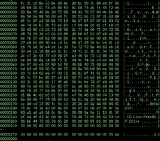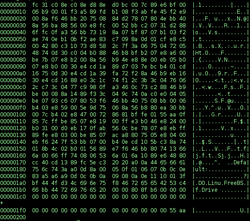
Executable
Encyclopedia

Computing
Computing is usually defined as the activity of using and improving computer hardware and software. It is the computer-specific part of information technology...
, an executable file causes a computer "to perform indicated tasks according to encoded instructions," as opposed to a data
Data (computing)
In computer science, data is information in a form suitable for use with a computer. Data is often distinguished from programs. A program is a sequence of instructions that detail a task for the computer to perform...
file that must be parsed by a program to be meaningful. These instructions are traditionally machine code
Machine code
Machine code or machine language is a system of impartible instructions executed directly by a computer's central processing unit. Each instruction performs a very specific task, typically either an operation on a unit of data Machine code or machine language is a system of impartible instructions...
instructions for a physical CPU
Central processing unit
The central processing unit is the portion of a computer system that carries out the instructions of a computer program, to perform the basic arithmetical, logical, and input/output operations of the system. The CPU plays a role somewhat analogous to the brain in the computer. The term has been in...
. However, in a more general sense, a file containing instructions (such as bytecode
Bytecode
Bytecode, also known as p-code , is a term which has been used to denote various forms of instruction sets designed for efficient execution by a software interpreter as well as being suitable for further compilation into machine code...
) for a software interpreter
Interpreter (computing)
In computer science, an interpreter normally means a computer program that executes, i.e. performs, instructions written in a programming language...
may also be considered executable; even a scripting language
Scripting language
A scripting language, script language, or extension language is a programming language that allows control of one or more applications. "Scripts" are distinct from the core code of the application, as they are usually written in a different language and are often created or at least modified by the...
source file may therefore be considered executable in this sense. The exact interpretation depends upon the use; while the term often refers only to machine code files, in the context of protection against computer virus
Computer virus
A computer virus is a computer program that can replicate itself and spread from one computer to another. The term "virus" is also commonly but erroneously used to refer to other types of malware, including but not limited to adware and spyware programs that do not have the reproductive ability...
es all files which cause potentially hazardous instruction execution, including scripts, are conveniently lumped together.
Generation of executable files
While an executable file can be hand-coded in machine language, it is far more usual to develop software as source codeSource code
In computer science, source code is text written using the format and syntax of the programming language that it is being written in. Such a language is specially designed to facilitate the work of computer programmers, who specify the actions to be performed by a computer mostly by writing source...
in a high-level language easily understood by humans, or in some cases an assembly language
Assembly language
An assembly language is a low-level programming language for computers, microprocessors, microcontrollers, and other programmable devices. It implements a symbolic representation of the machine codes and other constants needed to program a given CPU architecture...
more complex for humans but more closely associated with machine code instructions. The high-level language is compiled
Compiler
A compiler is a computer program that transforms source code written in a programming language into another computer language...
into either an executable machine code file or a non-executable machine-code object file of some sort; the equivalent process on assembly language source code is called assembly. Several object files are linked
Linker
In computer science, a linker or link editor is a program that takes one or more objects generated by a compiler and combines them into a single executable program....
to create the executable.
The same source code can be compiled to run under different operating systems, usually with minor operating-system-dependent features inserted in the source code to modify compilation according to the target. Conversion of existing source code for a different platform is called porting
Porting
In computer science, porting is the process of adapting software so that an executable program can be created for a computing environment that is different from the one for which it was originally designed...
. Assembly-language source code, and executable programs, are not transportable in this way.
Hardware
An executable comprises machine code for a particular processorCentral processing unit
The central processing unit is the portion of a computer system that carries out the instructions of a computer program, to perform the basic arithmetical, logical, and input/output operations of the system. The CPU plays a role somewhat analogous to the brain in the computer. The term has been in...
or family of processors. Machine-code instructions for different processors are completely different and executables are totally incompatible.
Some dependence on the particular hardware, such as a particular graphics card may be coded into the executable. It is usual as far as possible to remove such dependencies from executable programs designed to run on a variety of different hardware, instead installing hardware-dependent device driver
Device driver
In computing, a device driver or software driver is a computer program allowing higher-level computer programs to interact with a hardware device....
s on the computer, which the program interacts with in a standardised way.
Operating system
Some operating systemOperating system
An operating system is a set of programs that manage computer hardware resources and provide common services for application software. The operating system is the most important type of system software in a computer system...
s designate executable files by filename extension
Filename extension
A filename extension is a suffix to the name of a computer file applied to indicate the encoding of its contents or usage....
(such as .exe
EXE
EXE is the common filename extension denoting an executable file in the DOS, OpenVMS, Microsoft Windows, Symbian, and OS/2 operating systems....
) or noted alongside the file in its metadata
Metadata
The term metadata is an ambiguous term which is used for two fundamentally different concepts . Although the expression "data about data" is often used, it does not apply to both in the same way. Structural metadata, the design and specification of data structures, cannot be about data, because at...
(such as by marking an "execute" permission
File system permissions
Most current file systems have methods of administering permissions or access rights to specific users and groups of users. These systems control the ability of the users to view or make changes to the contents of the filesystem....
in Unix-like
Unix-like
A Unix-like operating system is one that behaves in a manner similar to a Unix system, while not necessarily conforming to or being certified to any version of the Single UNIX Specification....
operating systems). Most also check that the file has a valid executable file format
File format
A file format is a particular way that information is encoded for storage in a computer file.Since a disk drive, or indeed any computer storage, can store only bits, the computer must have some way of converting information to 0s and 1s and vice-versa. There are different kinds of formats for...
to safeguard against random bit sequences inadvertently being run as instructions. Modern operating systems retain control over the computer's resources, requiring that individual programs make system call
System call
In computing, a system call is how a program requests a service from an operating system's kernel. This may include hardware related services , creating and executing new processes, and communicating with integral kernel services...
s to access privileged resources. Since each operating system family features its own system call architecture, executable files are generally tied to specific operating systems, or families of operating systems.
There are many tools available that make executable files made for one operating system work on another one by implementing a similar or compatible application binary interface
Application binary interface
In computer software, an application binary interface describes the low-level interface between an application program and the operating system or another application.- Description :...
. (For example Wine
Wine (software)
Wine is a free software application that aims to allow computer programs written for Microsoft Windows to run on Unix-like operating systems. Wine also provides a software library, known as Winelib, against which developers can compile Windows applications to help port them to Unix-like...
, which implements a Win32
Windows API
The Windows API, informally WinAPI, is Microsoft's core set of application programming interfaces available in the Microsoft Windows operating systems. It was formerly called the Win32 API; however, the name "Windows API" more accurately reflects its roots in 16-bit Windows and its support on...
-compatible library for x86 processors)
When the binary interface of the hardware the executable was compiled for differs from the binary interface on which the executable is run, the program that does this translation is called an emulator
Emulator
In computing, an emulator is hardware or software or both that duplicates the functions of a first computer system in a different second computer system, so that the behavior of the second system closely resembles the behavior of the first system...
. Different files that can execute but do not necessarily conform to a specific hardware binary interface, or instruction set
Instruction set
An instruction set, or instruction set architecture , is the part of the computer architecture related to programming, including the native data types, instructions, registers, addressing modes, memory architecture, interrupt and exception handling, and external I/O...
, can be either represented in bytecode
Bytecode
Bytecode, also known as p-code , is a term which has been used to denote various forms of instruction sets designed for efficient execution by a software interpreter as well as being suitable for further compilation into machine code...
for Just-in-time compilation
Just-in-time compilation
In computing, just-in-time compilation , also known as dynamic translation, is a method to improve the runtime performance of computer programs. Historically, computer programs had two modes of runtime operation, either interpreted or static compilation...
, or in source code for use in a scripting language
Scripting language
A scripting language, script language, or extension language is a programming language that allows control of one or more applications. "Scripts" are distinct from the core code of the application, as they are usually written in a different language and are often created or at least modified by the...
. (see Shebang (Unix)
Shebang (Unix)
In computing, a shebang is the character sequence consisting of the characters number sign and exclamation point , when it occurs as the first two characters on the first line of a text file...
)
See also
- Object fileObject fileAn object file is a file containing relocatable format machine code that is usually not directly executable. Object files are produced by an assembler, compiler, or other language translator, and used as input to the linker....
- Comparison of executable file formatsComparison of executable file formatsThis is a comparison of executable file formats.Among the above formats, the ones in most common use are PE , ELF and Mach-O .- References :...
- Execution (computing)

